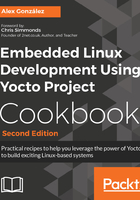
Getting ready
The recommended way to develop an embedded Linux system is using a native Linux workstation. Development work using virtual machines, such as the Build Appliance, is discouraged, although they may be used for demo and test purposes.
Docker containers are increasingly used as they provide a maintainable way to build the same version of Yocto over the course of several years, which is a common need for embedded systems with long product lifetimes. We will cover using Docker as a Yocto build system in the Using Docker as a Yocto build system container recipe in this same chapter.
Yocto builds all the components mentioned before from scratch, including the cross-compilation toolchain and the native tools it needs, so the Yocto build process is demanding in terms of processing power and both hard drive space and I/O.
Although Yocto will work fine on machines with lower specifications, for professional developers' workstations, it is recommended to use symmetric multiprocessing (SMP) systems with 8 GB or more system memory and a high capacity, fast hard drive, and solid state drives (SSD) if possible. Due to different bottlenecks in the build process, there does not seem to be much improvement above eight CPUs or around 16 GB RAM.
The first build will also download all the sources from the internet, so a fast internet connection is also recommended.